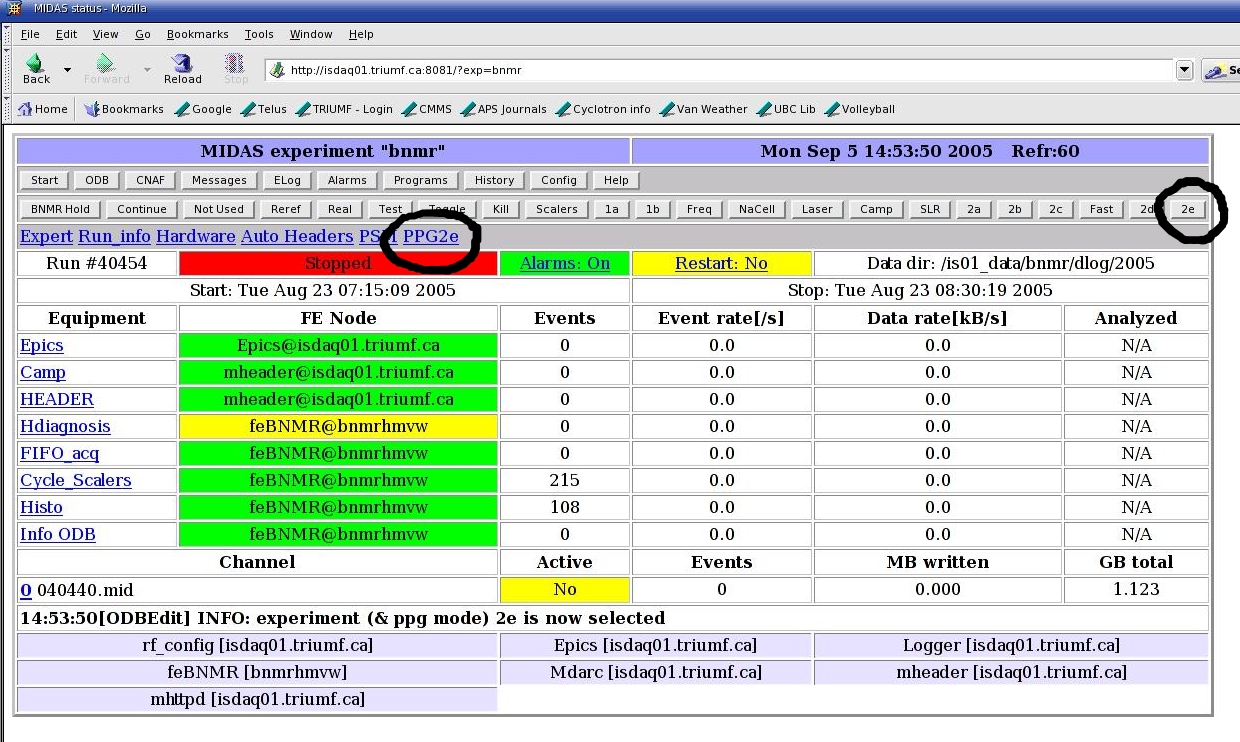
The ISAC β-NMR HomePage
| Introduction to β-NMR |
Publications |
Students Projects |
Contacts |
| Technical Information |
Data Acquistion |
Approved Experiments |
Internal Page |
| Related Links |
BNMR Wiki |
Data Analysis |
Photo Album |
|
|
How-to for BNMR/BNQR mode 2e
This webpage tries to replicate the
appearance of the isdaq01:8081/bnmr
webpage with the correct settings to run mode 2e, in dual mode (eg.
beam going to both bnqr and bnmr). Mode 2e, for those not in the know,
is a pulsed beam mode, with RF
applied during the beam pulse. The RF is a pulse (different than a
beam pulse), such as a Hermite
or ln-sech function. The
RF has a bandwidth and hence a
duration, and an amplitude,
which must all be set. Generally, you will use mode 2e to measure T1
during the first few
seconds, then sweep the frequency of the RF pulse through a resonance,
which will take a second or two, and then measure T1 again after you
switch off the beam. While the beam is OFF, it can be sent to
bnqr
(dual mode).
The webpages are arranged as you would see them on isdaq01, with similar links, but they are print screens of the webpages (nothing to click on). Click on the links I have made to find a certain page. These howto webpages are not intended to explain what each setting means, only to tell you what you should set it to and maybe why. Read the mode documentation on isdaq01 for more info or talk to Syd.
BNQR settings are very similar, but some settings are present different pages.
The settings shown on the webpage are for a 2e RF scan through a resonance at 4.1T, with frequency steps of 400Hz, a Hermite pulse of duration ~9ms with a bandwidth of 250Hz, and a T1 measurements for 3 seconds when the beam is switched off. Dual mode is enabled, meaning you (or someone else) would be doing a 2e or SLR/T1 experiment on bnqr simultaneously.
You should be able to modify any of these settings by following the links below.
The webpages are arranged as you would see them on isdaq01, with similar links, but they are print screens of the webpages (nothing to click on). Click on the links I have made to find a certain page. These howto webpages are not intended to explain what each setting means, only to tell you what you should set it to and maybe why. Read the mode documentation on isdaq01 for more info or talk to Syd.
BNQR settings are very similar, but some settings are present different pages.
The settings shown on the webpage are for a 2e RF scan through a resonance at 4.1T, with frequency steps of 400Hz, a Hermite pulse of duration ~9ms with a bandwidth of 250Hz, and a T1 measurements for 3 seconds when the beam is switched off. Dual mode is enabled, meaning you (or someone else) would be doing a 2e or SLR/T1 experiment on bnqr simultaneously.
You should be able to modify any of these settings by following the links below.
To quickly set up mode 2e for dual mode:
Please note: The dual channel mode for helecity flipping and kicker control ignores the access in epics, so no matter what access(BNMR or BNQR) you have, it will still work properly.To set up mode 2e in dual mode (beam
delivery to both bnqr and bnmr):
- Calculate the frequency range and increment you wish to measure and set it on page PPG2e.
- Decide what type of pulse you want (Hermite or ln-sech) and the bandwidth of the pulse. Set them on page PSM/IQ_modulation.
- Check the duration of the chosen RF pulse with Zaher's nifty convertor.
- Add one (1) ms to this pulse duration and define this as the "RF on time (ms)" on page PPG2e. This is the dwell time in ms.
- Decide whether you wish to measure the asymmetry by calculating slopes (3 measurements of the asymmetry per RF pulse) or by subtracting points (2 measurements of the asymmetry per RF pulse). Set this value in PPG2e.
- Calculate the length of time that scanning through the RF will take. Example: scan through 40kHz, in 400Hz steps, with a dwell time of 10ms, and calculating the slopes method. This means a scan will take 40E3/400*10ms*3=3000ms, or 3 seconds.
- Decide if you want to measure T1 before and after RF scans. Example: assume you want to measure two (2) seconds both before and after the RF scan. Now the total time of measurement will be 2sec + 3 sec + 2 sec. There is also a 2 dwelltime delay after the RF is turned off, while the beam is on (a default). Total measurement time is then 7.02 secs. We only need the beam on for 2sec + 3 sec, eg. during initial T1 and RF measurement.
- Now set the time structure of the pulse on page PPG2e. You will need to set num RF on delays, beam off time (ms), and num post RF beamOn dwelltimes.
- Change the values of Enable dual channel mode to "y" on page Hardware and and Helicity flip sleep (ms) and "DAQ service time (ms)" to "1" on page PPG2e..
Epics
switching: You must set
the epics beam delivery time and delay to appropriate values for the
chose time structure above. Example: taking the values above, we
need the beam control to go to bnmr for at least 5.5 sec. (0.5sec for
safety) and we need a
delay for the helicity plate to move into the laser beam and for the
commands to be sent, say 2 seconds. See Zaher's
documentation.
Call the operator (ext 7500) and ask for the IMS kicker to be turned ON and the Switch to be turned ON. Ask for BNMR and BNQR period of 5.5 seconds and a BNMR and BNQR delay of 2 seconds (following the example above). You should check that this is done on the EPICS control panel, under the second menu from the left, IMS Kicker/ BNMR/BNQR switching.
Call the operator (ext 7500) and ask for the IMS kicker to be turned ON and the Switch to be turned ON. Ask for BNMR and BNQR period of 5.5 seconds and a BNMR and BNQR delay of 2 seconds (following the example above). You should check that this is done on the EPICS control panel, under the second menu from the left, IMS Kicker/ BNMR/BNQR switching.
To quickly set up mode 2e for single mode:
Follow the steps 1 through 8
above. Then
10. Change the values of Enable dual channel mode to "n" on page Hardware and Helicity flip sleep (ms) to "2000" and DAQ service time (ms) to "2000" on page PPG2e.
Call the operator and ask for the Switch to be turned OFF and the IMS kicker to be turned ON.
10. Change the values of Enable dual channel mode to "n" on page Hardware and Helicity flip sleep (ms) to "2000" and DAQ service time (ms) to "2000" on page PPG2e.
Call the operator and ask for the Switch to be turned OFF and the IMS kicker to be turned ON.
Quick links:
These are the pages you need to
consult to switch to dual/single
mode,
set new frequency scan parameters, measure T1, or change the pulse type
or bandwidth:
To change the frequency range, frequency step, go to PPG2e.
To change the type of pulse and bandwidth, go to PSM/IQ_modulation
To change the length of the dwell time, go to PPG2e
To change the time structure of the pulse (dwell times before RF, during RF, or after RF, or beam ON or OFF before or after RF), go to PPG2e
To check the length of the pulse you have chosen, go Zaher's nifty convertor.
To switch between single (beam only to bnmr OR bnqr) and dual (beam to bnmr and then to bnqr) modes, go to Hardware and PPG2e
To change the Li count rate threshold, below which the experiment pauses counting, go to Hardware
To change the BNMR and BNQR Periods and Delays for the BNMR-BNQR Switching, see Zaher's documentation.
To change the frequency range, frequency step, go to PPG2e.
To change the type of pulse and bandwidth, go to PSM/IQ_modulation
To change the length of the dwell time, go to PPG2e
To change the time structure of the pulse (dwell times before RF, during RF, or after RF, or beam ON or OFF before or after RF), go to PPG2e
To check the length of the pulse you have chosen, go Zaher's nifty convertor.
To switch between single (beam only to bnmr OR bnqr) and dual (beam to bnmr and then to bnqr) modes, go to Hardware and PPG2e
To change the Li count rate threshold, below which the experiment pauses counting, go to Hardware
To change the BNMR and BNQR Periods and Delays for the BNMR-BNQR Switching, see Zaher's documentation.
Full description:
You are ready to run mode 2e when you
see a webpage like the one
below. Click on "2e" (circled in black to the right) and then you
should see after hitting reload "PPG2e" (circled to the left).
Click on the following links to see how each individual page should look. These are a reference in case something is changed you don't know what a value should be set to.
Click on the following links to see how each individual page should look. These are a reference in case something is changed you don't know what a value should be set to.
Expert
Run_info
Hardware
Auto_headers
PSM
PPG2e

Page last modified: 07/23/09 02:46 by Andrew MacFarlane.